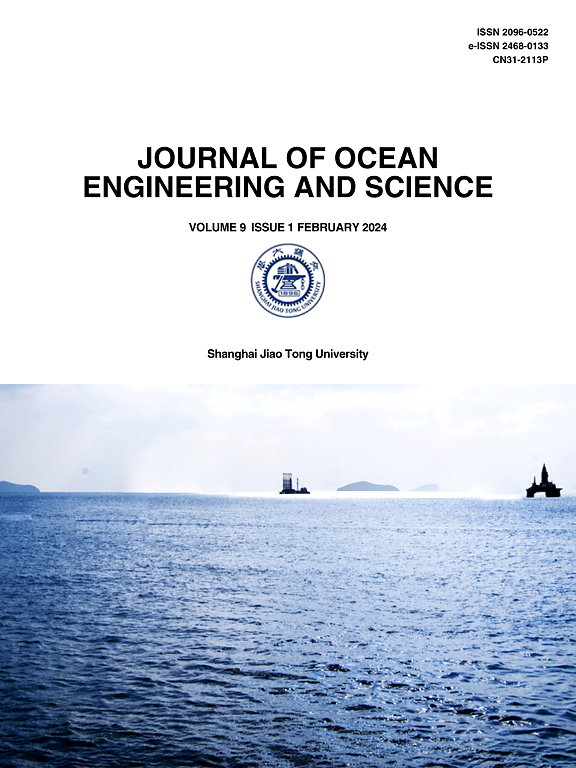浮动风力涡轮机的实时混合测试方法:关注空气动力载荷识别
IF 11.8
1区 工程技术
Q1 ENGINEERING, MARINE
引用次数: 0
摘要
由于浮式风力机的发展呈现出大容量、大转子尺寸的快速发展趋势,传统的全模型盆试验方法已经遇到了局限性。特别是风力发电系统(WGS)的尺寸与模型FWT系统的比例比之间的平衡。在这种情况下,混合模型试验方法为改进FWT模型试验提供了可能。在混合模型试验方法中,将原物理模型系统分为物理子系统和数值子系统,两个子系统之间的数据采集与处理模块起着重要的作用。本文首先建立了风力机物理模型与运动平台相结合的实时混合测试(RTHT)系统框架。对相应的数值代码进行了阻尼修正,提高了运动计算精度。采用延迟实现来避免运动发散。然后在数值环境下建立仿真回路,研究气动载荷的识别问题。分析了识别精度对RTHT结果的影响。最后,在RTHT系统中采用了气动载荷识别的双加速度计方法。通过衰减试验和非规则波试验验证了气动载荷识别方法的有效性。本文的工作初步证明了RTHT方法在浮式风力机模型试验中的能力和潜力。本文章由计算机程序翻译,如有差异,请以英文原文为准。
Real-time hybrid test method for floating wind turbines: Focusing on the aerodynamic load identification
Since the development of floating wind turbine (FWT) shows a rapid trend towards larger capacity and larger rotor size, the traditional full-model basin test method has encountered limits. Especially the balance between the wind generation system (WGS) size and scale ratio of the model FWT system. Under such circumstances, the hybrid model test method provides the possibility to improve the FWT model test. In the hybrid model test method, the original physical model system is divided into physical subsystem and numerical subsystem, and the data acquisition and process module between the 2 subsystems plays an important role. In this paper, a framework of real-time hybrid test (RTHT) system is setup firstly, which combines physical model wind turbine and motion platform. The damping modification to the corresponding numerical code is applied to improve the motion calculation accuracy. Delay implementation is employed to avoid motion divergence. Then a simulation loop is setup in numerical environment to study the identification of aerodynamic load. The influence of identification accuracy to the RTHT result is analyzed. Lastly, the dual-accelerometer method of aerodynamic load identification is employed in the proposed RTHT system. Decay tests and irregular wave only tests are carried out to validate the aerodynamic load identification method. The capability and potential of the RTHT method of floating wind turbine model test is preliminary proved in the work of this paper.
求助全文
通过发布文献求助,成功后即可免费获取论文全文。
去求助
来源期刊

Journal of Ocean Engineering and Science
Multiple-
CiteScore
11.50
自引率
19.70%
发文量
224
审稿时长
29 days
期刊介绍:
The Journal of Ocean Engineering and Science (JOES) serves as a platform for disseminating original research and advancements in the realm of ocean engineering and science.
JOES encourages the submission of papers covering various aspects of ocean engineering and science.
 求助内容:
求助内容: 应助结果提醒方式:
应助结果提醒方式:


